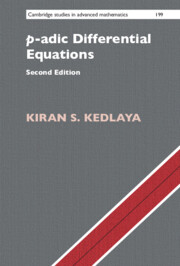Book contents
- Frontmatter
- Contents
- Preface
- Acknowledgments
- 0 Introductory remarks
- Part I Tools of p-adic Analysis
- Part II Differential Algebra
- Part III p-adic Differential Equations on Discs and Annuli
- Part IV Difference Algebra and Frobenius Modules
- Part V Frobenius Structures
- Part VI The p-adic local monodromy theorem
- 20 The p-adic local monodromy theorem
- 21 The p-adic local monodromy theorem: proof
- 22 p-adic monodromy without Frobenius structures
- Part VII Global theory
- Appendix A Picard–Fuchs modules
- Appendix B Rigid cohomology
- Appendix C p-adic Hodge theory
- References
- Index of notation
- Subject index
21 - The p-adic local monodromy theorem: proof
from Part VI - The p-adic local monodromy theorem
Published online by Cambridge University Press: 06 August 2022
- Frontmatter
- Contents
- Preface
- Acknowledgments
- 0 Introductory remarks
- Part I Tools of p-adic Analysis
- Part II Differential Algebra
- Part III p-adic Differential Equations on Discs and Annuli
- Part IV Difference Algebra and Frobenius Modules
- Part V Frobenius Structures
- Part VI The p-adic local monodromy theorem
- 20 The p-adic local monodromy theorem
- 21 The p-adic local monodromy theorem: proof
- 22 p-adic monodromy without Frobenius structures
- Part VII Global theory
- Appendix A Picard–Fuchs modules
- Appendix B Rigid cohomology
- Appendix C p-adic Hodge theory
- References
- Index of notation
- Subject index
Summary
In this chapter, we give a proof of the p-adic local monodromy theorem, at the full level of generality at which we have stated it in the previous chapter. After some initial reductions, we start with the case of a differential module satisfying the Robba condition. We describe how this case can be treated using either the p-adic Fuchs theorem for annuli or the slope filtration theorem. We then treat the rank 1 case using the classification of rank 1 solvable modules from Chapter 12. We then show that any module of rank greater than 1 and prime to ?? can be made reducible, by comparing the module with its top exterior power and using properties of refined differential modules. We finally handle the case of a module of rank divisible by ?? by considering its adjoint instead.
- Type
- Chapter
- Information
- p-adic Differential Equations , pp. 367 - 373Publisher: Cambridge University PressPrint publication year: 2022

